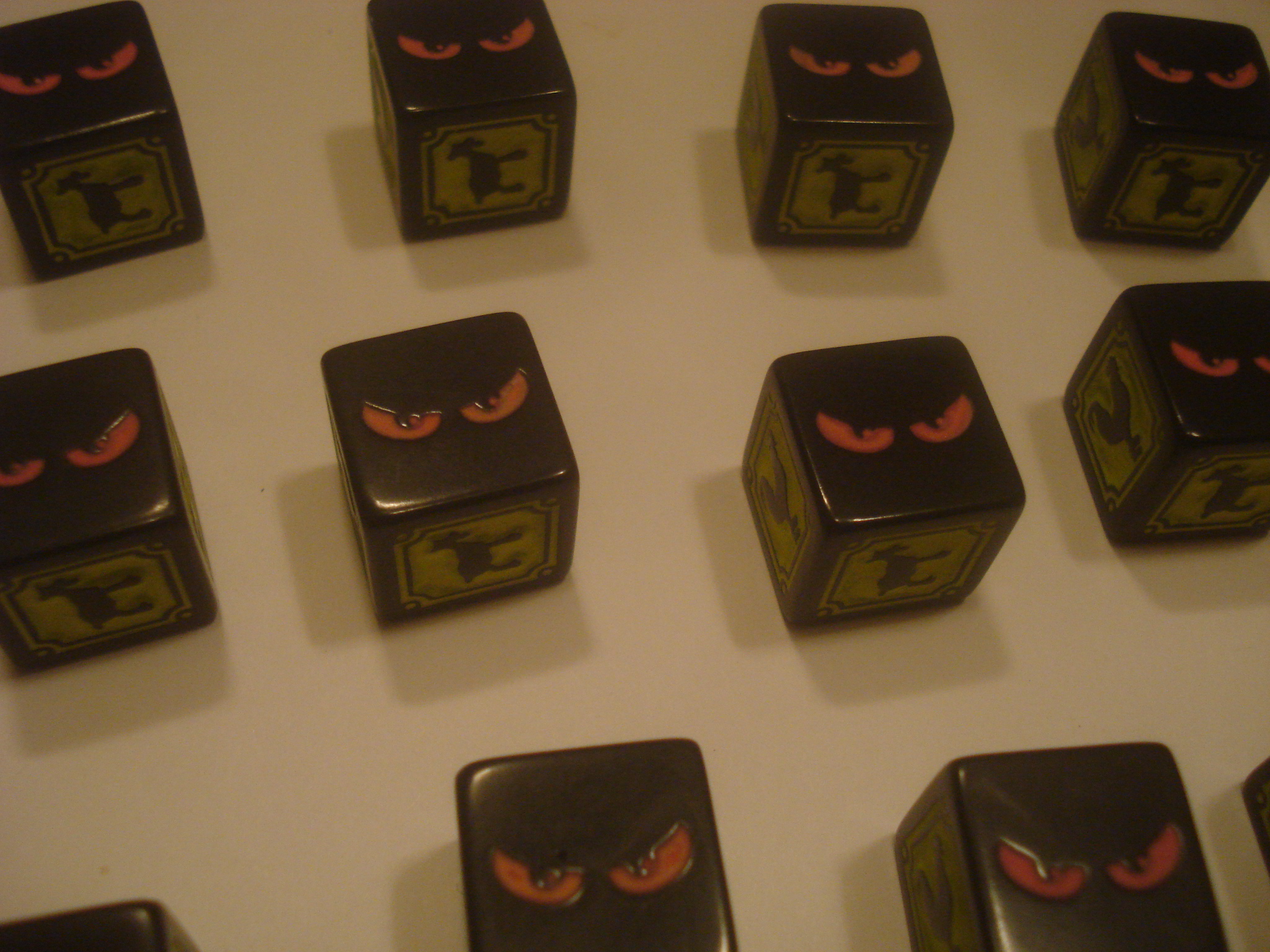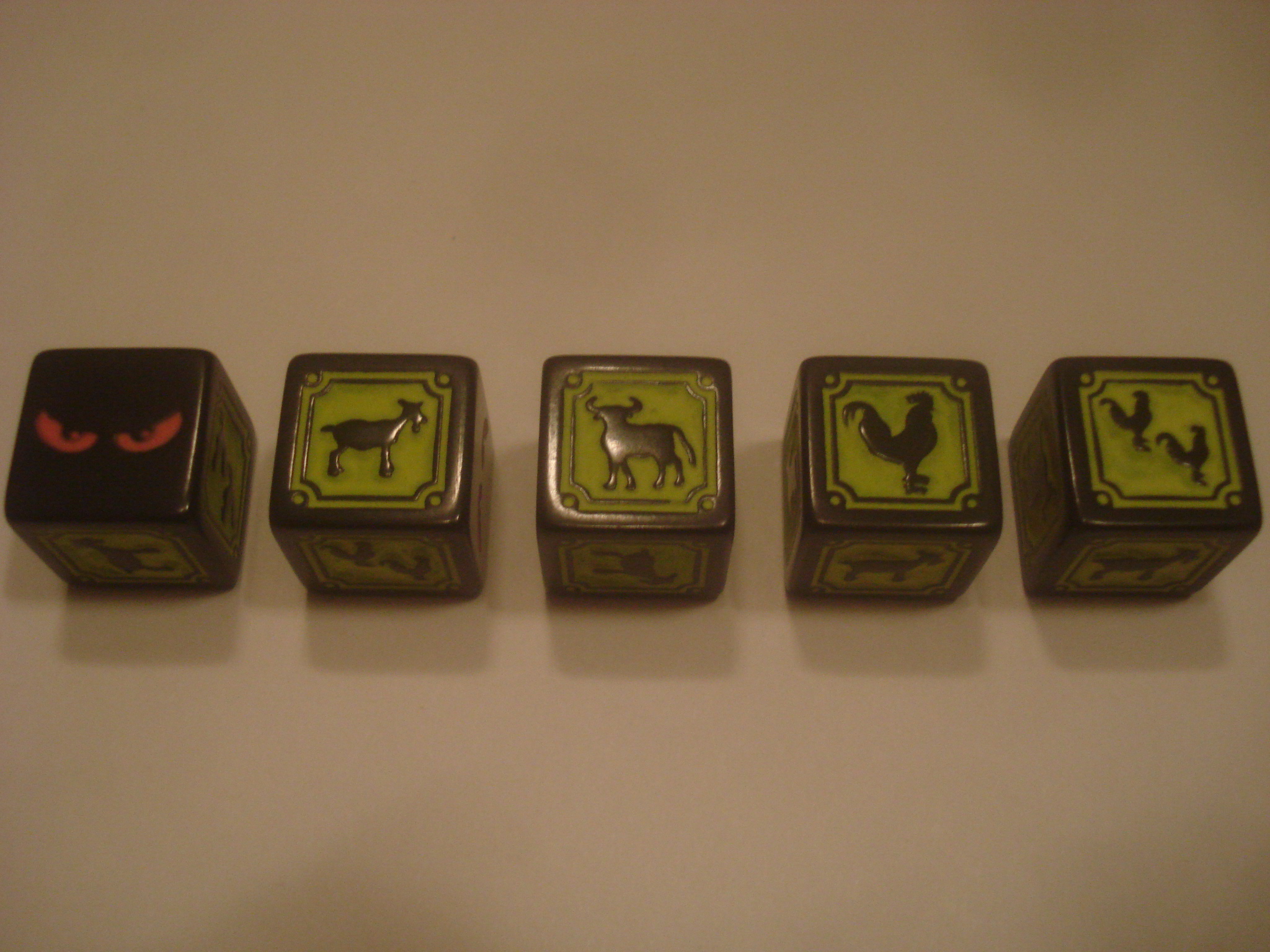| Publisher | Haywire Group, Inc. |
| Game Contents | 24 glow-in-the-dark chupacabra dice, starter chip, reference card, rules |
| Guidelines | Dice rolling (and stealing) chupacabra hunt |
| MSRP | $19.99 |
| Reviewer | Andy Vetromile |
You’d think with a rather specific name like “goat sucker,” your role in life would be pretty well-defined. Just when you think you have a handle on your place in the grand scheme of things, along comes a game to challenge your preconceived notions. Chupacabra: Survive the Night is a dice-rolling game of nocturnal horror and perseverance.
The object of the game is to be the “last mammal standing,” which is to say eliminate your opponents.
It’s not entirely clear whether you’re the livestock in a farmyard or the beast of legend itself. Said to come in the night and exsanguinate animals (particularly the eponymous goats), the chupacabra descend on the corrals and coops and chow down on anything that moves. Each player (two to four of them) gets a set of six dice, and each die shows a goat on two sides, a chicken on a third, two chickens on another, one steer, and a pair of glowing eyes – those last are the piercing orbs of the monster(s).
Players roll their dice simultaneously, and the starting player for the turn gets to munch his competition first. He can target any player with dice he can steal. With one chupacabra showing he can consume two chickens or one goat, while a steer requires two chupacabra results. One may only attack all the same animals in one “herd,” however – all chickens, goats, or steer. If insufficient chupacabra show up, he has to find easy pickings: a small herd, a weak animal type, or a different opponent altogether. The player takes any dice he “ate” and sets them off to one side.
Once he’s had his fill of a species, the next player gets to attack someone’s menagerie, and so on around the table. If you cannot grab something – you rolled no chupacabras or you haven’t dice enough to eat any existing herds – you go hungry for the turn. Any player who loses all his dice is eliminated while the remaining players begin a new round, passing the starter chip one person to the left and rolling anew. Now, however, any dice you stole from another player are added to your subsequent rolls. Once everyone else has been eaten, the last player is declared the winner.
From the get-go it’s easy to see how nice these dice are (there’s even a neat little window in the box to give the potential buyer a peek). You get two dozen of the plastic beauties and they have a lovely texture and feel about them. The rules are short (they fit in a space about the size of an index card), and the start player token is a stubby little puck that’s fun to spin around the table. The whole thing would fit in a small bag, which might be the way to go: The game box is ridiculously slippery, with an interior tray that simply slides out of the exterior sleeve and lets the components fall where they may. (It won’t slide out of your hand, mind, but it won’t stay shut either.) Of course, if it’s in a bag the rules might get bent no matter how small they are, but then they’re an impressive cardstock anyway and could poke you right through a standard Crown Royal felt sack. Good for defense against a chupacabra. Maybe those corners deserve a bit of denting. Losing the insert would be a shame since it’s covered in felt and staggered to give the dice a scattered look in their display.
Chupacabra involves a degree of thought, but not much. The canniest decision one can hope to make all game is to steal one set of livestock, knowing the next player hasn’t got the chupacabra results needed to grab any of the remaining ones. It makes great game custard, to fill in the space between other games, but it’s not terribly challenging. The dice glow in the dark, to such a degree that you actually can play with the lights off for a bit of fun, and an optional rule allowing down-on-their luck players to steal more barnyard pals with fewer chupacabra (otherwise it’s tough to make a comeback once you’re down to your last die) extends the life of the game.
Notwithstanding, it’s a mild distraction that won’t keep any but the younger players engaged for too long. Had they figured out a way to make the dice usable as regular six-siders into the bargain, it would have been an irresistible vanity purchase, but that would have been a neat trick given how elegantly sculpted the pieces are as-is. That leaves a $25 price tag as the box’s biggest hurdle. Chupacabra: Survive the Night might not go all through the night, but as one example in the current, burgeoning field of simple dice games, it earns marks for component quality that other, more solid designs, dice and otherwise, ought to boast of but don’t.



